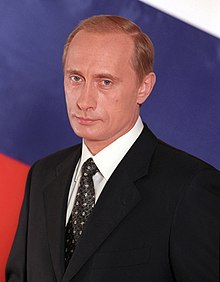
The Chapel of Russia's Resurrection is a sect from Russia that views President and ex-Prime Minister Vladimir Putin as the reincarnation of Paul the Apostle.

The Chapel of Russia's Resurrection is a sect from Russia that views President and ex-Prime Minister Vladimir Putin as the reincarnation of Paul the Apostle.
The sect was founded in 2007[ citation needed ] by a person known as Mother Fotina, whose real name is thought to be Svetlana Frolova;[ citation needed ] she is also thought to have been a former convict who had been a railroad worker. [1] It is a schism away from the Russian Orthodox Church. The sect lives in an sanctuary located in Bolshaya Yelnia, near the Volga River and Nizhny Novgorod, [2] established by Mother Fotina.
The sect believes that Russian Prime Minister and now Russian President Vladimir Putin is the reincarnation of Paul the Apostle, sent to Russia to prepare its people for the Second Coming of Christ; [3] Putin is also thought to have joined with seven other reborn apostles to fight the antichrists. [4] Mother Fotina notes the similarities between Paul and Putin's careers, including being an early "persecutor of Christians" before becoming imbued with the Holy Spirit; the group believes that Putin received the Holy Spirit after becoming president. [2] Putin is also said to be a reincarnation of Vladimir the Great. [4]
Putin is the first Russian leader to be religiously worshiped while still alive. [4]
The group, consisting entirely of women, dress as nuns when giving services to pray for Putin in a three-story brick building called the Chapel of Russia's Resurrection. [3] They have put a picture of him, said to have appeared miraculously one day,[ citation needed ] together with traditional Russian Orthodox figures. At the services, they also sing patriotic Russian songs, [2] as well as the children's song "May There Always Be Sunshine". [4]
The Russian government is aware of the sect, and Putin's press agent Dmitry Peskov has stated that "it is impressive that [the sect] think so highly of [Putin's] work." Although he notes that the group has not broken any laws, he reminds them that one of the commandments in the Bible is that "thou shalt not worship false idols". The sect has arisen amid a personality cult centered on Putin, which includes popular songs, and nightclub parties.[ citation needed ]
Father Alexei, a local Russian Orthodox priest, has denounced the sect as a mix of "Orthodoxy, Catholicism, the occult, Buddhism and political information." [2] A neighbour of Mother Fotina's has opined that the sect was started to keep the Federal Security Service from investigating its founder. [3]
The Apostles' Creed, sometimes titled the Apostolic Creed or the Symbol of the Apostles, is a Christian creed or "symbol of faith".

A crucifix is a cross with an image of Jesus on it, as distinct from a bare cross. The representation of Jesus himself on the cross is referred to in English as the corpus.

The Khlysts or Khlysty were an underground Spiritual Christian sect which emerged in Russia in the 17th century.

The Ascension of Jesus is the Christian belief, reflected in the major Christian creeds and confessional statements, that Jesus ascended to Heaven after his resurrection, where he was exalted as Lord and Christ, sitting at the right hand of God.

Nicholas (Kasatkin), Equal-to-the-Apostles, Archbishop of Japan, born Ivan Dmitrovich Kasatkin (Russian: Иоанн Димитриевич Касаткин; 13 August [O.S. 1 August] 1836 – 16 February 1912) was a Russian Orthodox priest, monk, and bishop. He introduced the Eastern Orthodox Church to Japan. The Orthodox cathedral of Tokyo (metropolitan diocese of Japan), Tokyo Resurrection Cathedral, was informally named after him as Nikorai-do, first by the local community, and today nationwide, in remembrance of his work.
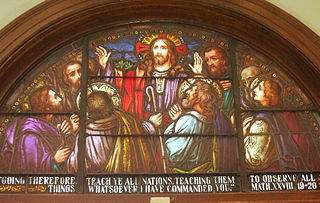
In Christianity, the Great Commission is the instruction of the resurrected Jesus Christ to his disciples to spread the gospel to all the nations of the world. The Great Commission is outlined in Matthew 28:16–20, where on a mountain in Galilee Jesus calls on his followers to make disciples of and baptize all nations in the name of the Father, the Son, and the Holy Spirit.
In the Eastern Orthodox Church, the feast of the Resurrection of Jesus, called Pascha (Easter), is the greatest of all holy days and as such it is called the "feast of feasts". Immediately below it in importance, there is a group of Twelve Great Feasts. Together with Pascha, these are the most significant dates on the Orthodox liturgical calendar. Eight of the great feasts are in honor of Jesus Christ, while the other four are dedicated to the Virgin Mary — the Theotokos.
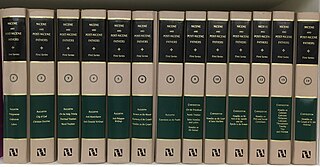
Sacred tradition, also called holy tradition or apostolic tradition, is a theological term used in Christian theology. According to this theological position, sacred tradition is the foundation of the doctrinal and spiritual authority of Christianity and of the Bible. Thus, the Bible must be interpreted within the context of sacred tradition and within the community of the denomination. The denominations that ascribe to this position are the Catholic, Eastern Orthodox, and Oriental Orthodox churches, and the Assyrian churches.

Eastern Orthodoxy, otherwise known as Eastern Orthodox Christianity or Byzantine Christianity, is one of the three main branches of Chalcedonian Christianity, alongside Roman Catholicism and Protestantism. Like the Pentarchy of the first millennium, the mainstream Eastern Orthodox Church is organised into autocephalous churches independent from each other. In the 21st century, the number of mainstream autocephalous churches is seventeen; there also exist autocephalous churches unrecognized by those mainstream ones. Autocephalous churches choose their own primate. Autocephalous churches can have jurisdiction (authority) over other churches, some of which have the status of "autonomous" which means they have more autonomy than simple eparchies.

In Christianity, the Lord's Day refers to Sunday, the principal day of communal worship. It is the first day of the week in the Hebrew calendar and traditional Christian calendars, with the exception of European (workweek) calendars. It is observed by most Christians as the weekly memorial of the resurrection of Jesus Christ, who is said to have been raised from the dead early on the first day of the week. The phrase appears only once in Rev. 1:10 of the New Testament.

The Archdiocese of Thyateira and Great Britain is an archdiocese of the Ecumenical Patriarchate of Constantinople in the Eastern Orthodox Church. The incumbent archeparch is Nikitas Loulias. Its jurisdiction covers those Orthodox Christians living in Great Britain, the Republic of Ireland, the Isle of Man, and the Channel Islands. The adherents are largely of Cypriot Greek descent, mainland Greek migrants and their descendants, and more recently native British converts along with a few Poles, Belarusians, and Ukrainians. The episcopal seat is the Cathedral of Holy Wisdom which is situated in the city of London.
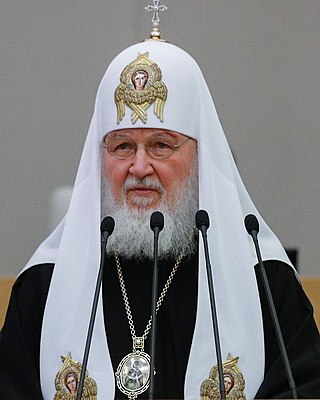
Kirill or Cyril is a Russian Orthodox bishop. He became Patriarch of Moscow and all Rus' and Primate of the Russian Orthodox Church on 1 February 2009.
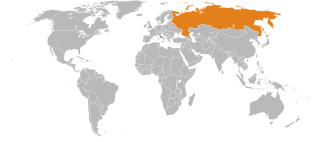
Holy See–Russia relations are the bilateral relations between the Holy See and Russia. The Holy See has an Apostolic Nunciature in Moscow. Russia has a permanent representative to the Holy See based in Rome.

The Catholic Church and the Eastern Orthodox Church have been in a state of official schism from one another since the East–West Schism of 1054. This schism was caused by historical and language differences, and the ensuing theological differences between the Western and Eastern churches.

The Cincture of the Theotokos is believed to be a relic of the Theotokos, now in the Vatopedi monastery on Mount Athos, which is venerated by the Holy Eastern Orthodox Church. The word "cincture" is sometimes also translated as "belt", "sash" or "girdle". It is the Orthodox equivalent of the Girdle of Thomas in the Western church, and the Syriac Holy Girdle. Its feast day is September 13.
The history of Eastern Orthodox Christian theology begins with the life of Jesus and the forming of the Christian Church. Major events include the Chalcedonian schism of 451 with the Oriental Orthodox miaphysites, the Iconoclast controversy of the 8th and 9th centuries, the Photian schism (863-867), the Great Schism between East and West, and the Hesychast controversy. The period after the end of the Second World War in 1945 saw a re-engagement with the Greek, and more recently Syriac Fathers that included a rediscovery of the theological works of St. Gregory Palamas, which has resulted in a renewal of Orthodox theology in the 20th and 21st centuries.
The Nicene Creed, composed in part and adopted at the First Council of Nicaea (325) and revised with additions by the First Council of Constantinople (381), is a creed that summarizes the orthodox faith of the Christian Church and is used in the liturgy of most Christian Churches. This article endeavors to give the text and context of English-language translations.
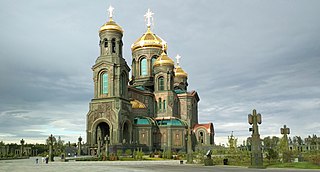
The Main Cathedral of the Russian Armed Forces is a lavish Russian Patriarchal cathedral in honour of the Resurrection of Christ and "dedicated to the 75th anniversary of victory in the Great Patriotic War, as well as the military feats of the Russian people in all wars", built in the Patriot Park in the Odintsovsky District, Moscow Oblast.

The Diocese of Makhachkala is a diocese of the Russian Orthodox Church on the territory of Dagestan, Ingushetia and Chechnya with its seat in the city of Makhachkala, the capital of the Republic of Dagestan, Russia. The main temple is the Cathedral of the Assumption.